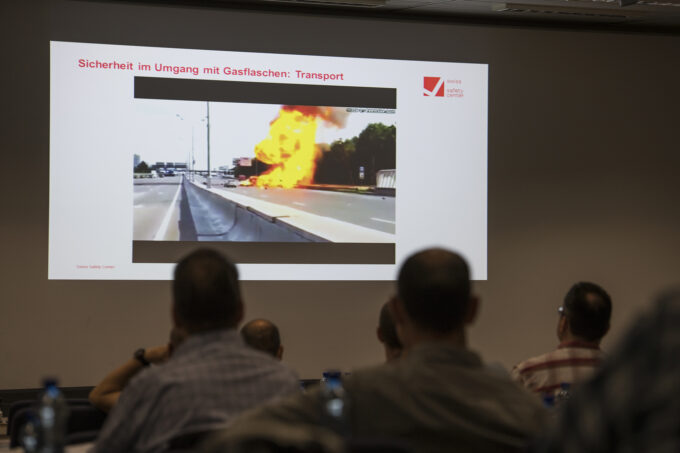The Dangerous Goods Day Switzerland - for the annual overview
The 20th Dangerous Goods Day Switzerland took place in mid-June at EuroAirport Basel. Enclosed is the follow-up report on the anniversary event, a practice-oriented training and further education module in the field of complex dangerous goods regulations.

After last year's ADR regulations celebrated an anniversary, this year's Dangerous Goods Day Switzerland was to celebrate a round birthday: The event took place for the 20th time this year, proving not least its unbroken appeal for those responsible in the dangerous goods sector. This year, participants once again received the already familiar, comprehensive overview of the current and upcoming status of regulations, as well as insight into special areas of dangerous goods transport.
Innovations, amendments and repealed transitional arrangements
Every two years, innovations and amendments to the SDR/ADR come into force, and this will be the case again at the beginning of 2019. Beat forge from the Federal Roads Office presented the most important of these in a lecture clearly structured according to topic. The fact that lithium batteries are also affected by changes comes as no surprise to anyone, as their development is still so rapid that the regulations inevitably have to react to them at very short intervals. In addition to the further innovations, however, transitional regulations must also be taken into account, which will be repealed as of 1 January 2019.
Despite their large number, the most important changes and innovations were conveyed to the participants in a short time, in an understandable manner and in a lively presentation. The second speaker captivated the audience right from the start with a short film showing the dramatic consequences that can occur if a delivery van loses poorly secured gas cylinders en route. However, gas cylinders can not only be dangerous during transport, their storage can also be hazardous after initial use. Jack Winteler from the Swiss Safety Center explained the testing methods and intervals for refillable gas cylinders and used exhibits showing different types of damage to illustrate the importance of such tests.
Air and sea freight with dangerous goods
Fabrizio Simona (Swiss Post) and Rosanna Cataldo (Federal Office for Civil Aviation) provided information on the restrictions and security measures for dangerous goods consignments by air. As Swiss Post only operates within national borders, it cannot guarantee the entire transport chain for cross-border deliveries. For this reason, Swiss Post only transports certain dangerous goods that are clearly defined in the Dangerous Goods Regulation. This repeatedly leads to a lack of understanding on the part of customers and an intensive training effort on the part of Swiss Post. The effort involved is very high, but justified in view of the risk potential.
The situation is quite different for Hapag-Lloyd, which ships hazardous goods worldwide and in large quantities by sea. Ken Rohlmann (Senior Director Dangerous Goods at Hapag-Lloyd) repeatedly stressed that the biggest challenge is that dangerous goods are often not declared as such. Correctly declared dangerous goods, on the other hand, can be shipped without any problems if they comply with national guidelines and the company's internal rules. In view of the 7,000 or so ports with their own rules and countless national regulations, however, the freight documents quickly become complicated if a freighter calls at several ports in succession. In addition, there is the very complex stowage planning, which ensures that the containers are placed optimally and in accordance with the IMDG regulations, the loading and unloading sequence and the heeling movements of the ship. For example, Hapag-Lloyd only transports dangerous goods containers at selected positions that are safely protected. After all, captains shy away from nothing more than fire on board. Every effort is made - as explained below - to detect undeclared dangerous goods before they come on board undetected.
Proven and new specialist modules
In the afternoon, participants again had a choice of various specialist modules in which specific knowledge was imparted in smaller groups. As in previous years, the participants had to complete a dangerous goods course, where technical and practical knowledge was required at the various posts. The interactive dangerous goods quiz, in which simple and more complex questions had to be answered within a time limit, took a playful approach. Participants immediately received an anonymous evaluation of their answers. Another module provided information on the software developed by Hapag-Lloyd together with IBM, which detects undeclared dangerous goods. For this purpose, the freight documents are scanned and searched for an extensive list of terms as well as for strange combinations.
The system currently reports around 1200 suspicious freight bookings with manipulated documents or photos every day, almost all of which originate from the same three regions of the world. The transport of dangerous goods is more complex and therefore more expensive than that of other goods, so that the temptation to save money at the expense of safety is unfortunately great. The exemptions in dangerous goods law always meet with great interest. Thus, many participants attended this specialist module to find out about the exemptions for dangerous goods in machinery that are no longer applicable and the correct application of the many different exemptions.









